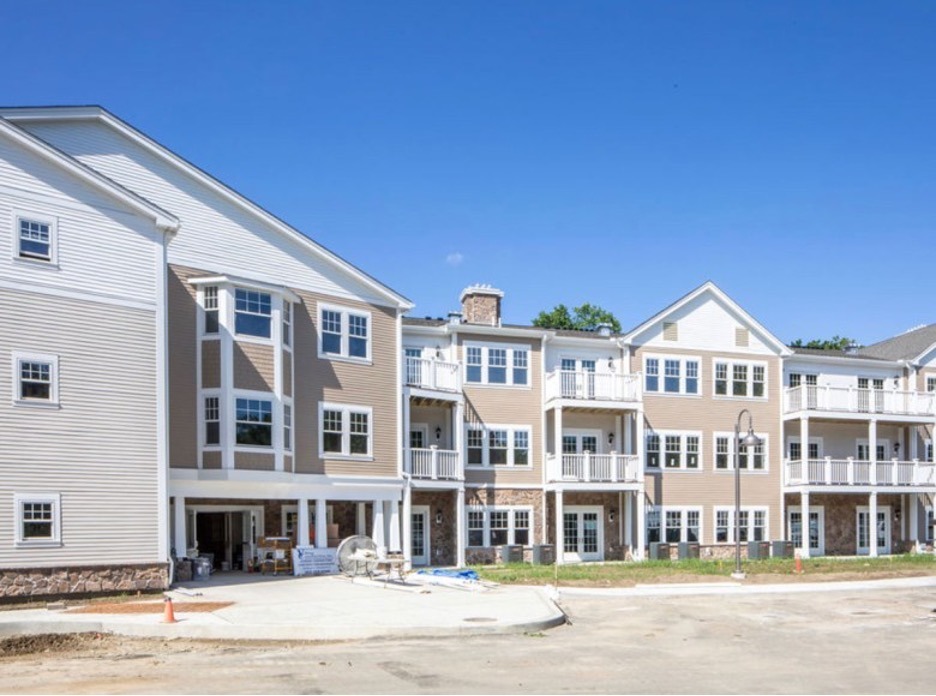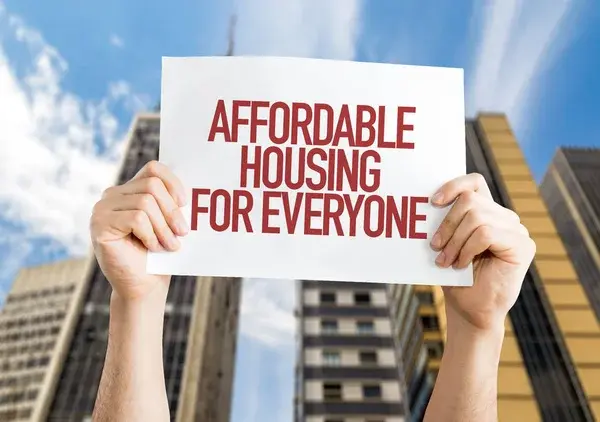By Barbara Heimlich
Editor
Sources: Desegrate Connecticut; Jamil Ragland; Fairfield County’s Center for Housing Opportunity, Ginny Monk, Housing and Children’s Issues Reporter, CT Mirror

To address the affordable housing crisis in Connecticut, the Connecticut legislature passed General Statutes Sec. 8-30j in 2017, requiring every municipality to adopt an affordable housing plan by June 1, 2022. Fairfield County’s Center for Housing Opportunity (FCCHO) has developed scorecards to assess the plans in Fairfield County and the degree to which they will make our region more affordable for everyone. The criteria were developed using the guidance outlined in the Planning for Affordability in CTguidebook published by the Connecticut Department of Housing. Affordable housing is defined as housing where tenants spend 30% or less of their income on housing costs.
So where does Stratford stand on affordable housing? The Stratford FCCHO scorecard rated us 2.5 out of a top score of 5. Underperforming score to say the least!
“Housing Strategies”, a report adopted by the Stratford Town Council on May 10, 2021, was prepared by the Stratford Housing Partnership and the complete report is available on the Housing Partnership webpage on the Town website. GOAL: Seek to provide for a variety of housing choices in Stratford for people and households of all ages and characteristics. To view the document go to: https://www.townofstratford.com/o/stratford/page/stratford-housing-partnership
In many respects, Connecticut’s housing crisis is hyper-magnified in Fairfield County, which has the highest rate of income inequality of any metropolitan area in the United States and is one of the nation’s most racially segregated places. In 2019, national reporting about residential segregation in Connecticut focused primarily on communities in Fairfield County. Today the county lacks 25,000 homes affordable to residents making 0-30% of area median income, the largest such gap of any Connecticut county. Extreme wealth coexists with extreme poverty, and the housing stock and health outcomes of residents reflect this: Residents of the state’s largest city, Bridgeport, have a life expectancy that is a decade shorter than residents who live 20 minutes down the road in Westport.
In 2020, FCCHO collaborated with national systems change expert Dr. Tiffany Manuel to facilitate a series of focus groups with Fairfield County residents to determine how residents felt about housing and related issues. This exercise found that housing affordability was not a commonly shared goal among residents, and that residential segregation of wealthier white people in the suburbs and lower-income people of color in the cities was commonly accepted as “the way it is.”
By taking action to create and implement substantive affordable housing plans, towns and COGs have the opportunity to change “the way it is” and proactively shape and determine their own housing futures, demonstrating that Fairfield County can be a great place to live and be more affordable, and that a high quality of life and an affordable life are compatible and not tradeoffs. By detailing how they will meet the housing needs of existing and new residents and businesses and what sort of housing options they will make available moving forward, these plans will help determine whether Fairfield County communities thrive or merely survive going forward.
FCCHO brings together a diverse coalition of practitioners, policy makers, residents, community organizations and partners across sectors to build capacity, align resources and change the conversation around housing affordability in Fairfield County. FCCHO is a strategic partnership between Fairfield County’s Community Foundation, the Housing Collective, Partnership for Strong Communities and Regional Plan Association.
As the state’s affordable housing crisis deepens, a local nonprofit is set to receive significant financial support from a national organization dedicated to increasing affordable housing options.
Connecticut Housing Partners (CHP), a nonprofit organization based in Trumbull, will receive part of $75.7 million being distributed by NeighborWorks America. The money is being distributed among nearly 250 nonprofits across the country, and will support CHP’s real estate development team, which creates affordable housing in the state. Connecticut Housing Partners has been a chartered member of the NeighborWorks America network since 1994. They will be receiving $197,000 that will be used to leverage other funds to continue their mission of building affordable housing. In Connecticut, seven housing providers are part of the NeighborWorks network, including NeighborWorks New Horizons in New Haven, Neighborhood Housing Service of New Britain and Mutual Housing Association of Greater Hartford.
What’s missing? Stratford working with NeighborWorks. We have a grant writer, Molly Ryan. Has she applied for a grant from NeighborWorks America?
A partnership with NeighborWorks, a nonprofit with network partners in every state, provides more than grant funding. As part of its mission to support affordable housing development across the nation, NeighborWorks also provides technical assistance, evaluation tools, and training for housing and community development professionals.
“We are excited about these grant awards and honored to collaborate with NeighborWorks America,” said Renée Dobos, president, and CEO of Connecticut Housing Partners. “This funding is critical in providing our team with the support, training, and technology needed as we do the work to address Connecticut’s housing shortage.”
CHP has developed or acquired several affordable housing projects in Connecticut over the last 30 years, and has supported housing options ranging from homeownership and traditional rentals to senior and supportive housing. Its efforts are primarily focused in southern Connecticut and its properties can be found in Bridgeport, Trumbull, Stamford, and Wilton. Monroe is presently working with CHP to develop their path to affordable housing.
According to the Connecticut Housing Finance Authority (CHFA), the state has several constraints that make it difficult to locate affordable housing for residents. Between 2016 and 2021, the state saw a more than 3% increase in the number of new households. Then the COVID-19 pandemic arrived, driving more residents to seek single-family homes. By May 2023, 5,900 homes across the state were listed for sale, which represents only 30% of the number of homes listed in May 2019. Home prices responded accordingly, jumping by 32% from a median of $234,500 in 2019 to $310,000 in 2022.
These increases in price have put home ownership, and in some cases even renting, out of reach for some families. In particular, extremely low-income households are facing dire situations when searching for housing. Data from the National Low Income Housing Coalition shows that Connecticut is falling short by almost 100,000 units for extremely low-income residents. Almost 150,000 renter households, or 31% of all renter households, qualify as extremely low income.
Legislative efforts to incentivize new affordable housing in the state fell short during the last legislative session. House Bill 5390, known as the “Work, Live, Ride” bill, would have provided incentives for municipalities to construct new housing near existing public transportation hubs.
The bill was controversial, however, as it would have allowed qualifying development projects to skip the public comment phase of new development approval and move straight to construction. The bill cleared the House, but died in the Senate without receiving a vote. It’s left advocates and lawmakers frustrated with the slow progress of policies that aim to expand affordable housing in Connecticut.
The Democrats’ major housing bill — an omnibus bill that included a wide range of solutions — will just scratch the surface, advocates and lawmakers said. The bill notably allows the conversion of nursing homes to multi-family housing without a special hearing before town zoning commissions and offers towns incentives to build more “middle housing,” or homes such as duplexes, triplexes or townhomes.
“I don’t know that we passed anything that kind of meets the moment,” said House Majority Leader Rep. Jason Rojas, D-East Hartford. He called the work of the most recent session “painful incrementalism.”
Rojas’ bill offered points toward getting a temporary moratorium from the state’s 8-30g law if towns allow middle housing without a special hearing in front of the zoning commission. The 8-30g law offers court remedies to developers if their proposals for affordable housing are denied. Towns are exempt if at least 10% of their housing stock is designated affordable and can achieve temporary moratoriums as they build more affordable housing.
Rojas’ bill also included a requirement that landlords give 45 days notice of rent increases and required towns allow abandoned nursing homes to be turned into multi-family housing.
Planning and Development co-chair Sen. MD Rahman, D-Manchester, said it will likely take more than one legislative session to address the lack of affordable housing, but said the bill makes “important steps.”
My Home Connecticut!
Affordable Housing in Stratford
By Barbara Heimlich
Editor
CT Planning and Development ranking member Sen. Ryan Fazio, R-Greenwich, said it’s one of his priorities. He said he’d like to change the definition of affordable housing to include more types of housing and have a fixed denominator when figuring the 10%, so the goal doesn’t move as towns build more housing that’s not designated affordable.
“I would say overall, it’s still a deeply frustrating issue because we can’t make the progress we want to make,” said Senate Majority Leader Sen. Bob Duff, D-Norwalk.
The problem has been a long time coming, said Sen. Rick Lopes, D-New Britain, a former chair of the Housing Committee.
“The only difference I see is back then in the housing committee, we saw that we were heading toward a significant problem in terms of housing availability,” Lopes said. “And now it’s here.”
Housing Committee co-chair Sen. Marilyn Moore, D-Bridgeport, said this was the first session in a decade in the legislature that she felt she didn’t accomplish as much as she wanted to. “Do we really have the will to make these changes?” Moore said. “Because I do believe poverty is intentional. If we’re not willing to address poverty, then nothing is going to change.”
Experts have attributed the lack of affordable housing in Connecticut to restrictive local zoning ordinances that make it hard to build multi-family housing on most of the state’s land. This disproportionately shuts people with low incomes and people of color out of certain towns.
Housing and particularly statewide zoning reform initiatives have been a sort of political football in Connecticut for many years, and this in an election year when incumbent lawmakers are defending their seats, it’s a particularly sensitive topic.
Maria Weingarten, a member of the group 169 Strong, said the group liked some aspects of the bill, but would have preferred it didn’t allow development “as-of-right,” or without a special hearing before the zoning commission. The group, which has opposed many land use reform efforts, also wants to see 8-30g reform, she said.
“I feel like it’s always Groundhog Day,” Weingarten said. “It really is what it is unfortunately. Sort of the same proposals get hashed out again and again. The only issue that’s truly missing is working with local leaders. A one-size policy will never work.”
A proposal to push towns to increase density near train and bus stations from Desegregate Connecticut made it through the House — the farthest it’s come in recent sessions — before dying in the Senate. Lawmakers say they ran out of time to call it.
“On the one hand, if you told me in a short session you would get 90 votes in the House and the governor would be on board, that would be amazing,” said Pete Harrison, Connecticut director for the Regional Plan Association. “It’s really hard to do anything with a statewide zoning bill. On the other hand, to know we have the votes in the Senate and to not see it get called and see it get through is really frustrating.”
Duff said the bill would likely be back next year. Rojas said because home is one of the most personal things in a person’s life, changes to zoning can feel personal. It makes it politically difficult to pass zoning legislation, he said.
“Those who are secure in their housing are comfortable and perceive change as a threat to the largest investment you’ll ever make,” Rojas said.
Republicans said they want to see a more nuanced solution.
“I think we really need to commit ourselves to a global solution to housing,” said Planning and Development ranking member Rep. Joe Zullo, R-East Haven. “I think that’s going to involve a realistic transit-oriented development plan and a realistic reform of 8-30g.”
The proposal offered some priority funding of state dollars to towns that created transit districts — or denser districts with more housing near public transit. Towns would not be disqualified from getting funding if they did not create the districts.
Weingarten said she wants to see more consideration given to the “scale,” of nearby buildings in zoning proposals.
“At least it’s within the scale of what’s already existing, so it doesn’t stick out,” she said. “That’s reflective of what’s existing in the environment.”
Harrison said the bill aimed to allow towns to decide to build the districts and would allow community members to speak up about what they want to see in the transit districts.
“I’m very comfortable that the bill is really good policy, it’s good politics, but really at the heart of what Work, Live, Ride is trying to do, it’s not really trying to solve it at the state level, it’s trying to create the space for local organizing,” he said.



